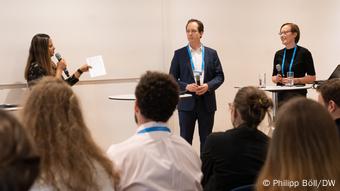Data Journalism: Why Usability Is More Than ‘Nice to Have’
MEDIA, 7 Nov 2022
Antonia Sanke interviews Christina Elmer | Deutsche Welle - TRANSCEND Media Service
Why do media outlets need data journalism? Prof. Christina Elmer shares her expertise on how to become a data journalist and the future of digital media.

Prof. Christina Elmer recommends aspiring data journalists to learn a programming language like R or Python.
31 Oct 2022 – Christina Elmer is professor of Digital and Data Journalism at TU Dortmund University and one of the most renowned data journalists in Germany. She talked to DW on the basics of her trade, must-haves for aspiring data journalists and the future of digital and data journalism.
DW: What is data journalism — and why do media outlets need more of it?
Christina Elmer: Data journalism describes the ability to analyze and visualize data sets as a source in journalistic investigations. This competence also helps decisively in exploiting large leaks, breaking down topics regionally, and evaluating statistics independently with individual questions. As data journalism enables reporters to use extensive digital sources and datasets, I’d regard it to be one fundamental part of the current investigation competency kit.

At the 2022 DW Global Media Forum, Christina Elmer (right) took part in a discussion on the future of journalism
Content Comes First — but Usability Is Crucial
Why is usability of news media not only “nice to have”?
Because the competition in the digital space is far too great. People are used to finding information in their feeds in suitable formats. Even on mobile devices and on the move, for example on social media platforms that are technically state of the art. Usability is therefore one of the decisive success criteria for news media. But of course, content comes first.
What technology will most shape the media industry of tomorrow?
From my point of view, learning algorithms and automated personalization offer an enormously exciting development space for media. But in order to fill this space with journalism, we also need a stronger discussion of content: How can we update and operationalize relevance criteria, that is how can we explain them to the algorithms? In this field, there are several interlocking challenges that have to be met.
How do ethical dimensions influence digital media work?
Ethical decisions play a major role in digital publishing — especially where content is personalized and systems are involved in the background that users do not intuitively understand. Journalists have a great responsibility to explain their methods and make sources transparent. In digital journalism, this can sometimes be very complicated and technical, which is why we discuss these challenges quite intensively with our students.
What would you recommend to aspiring data journalists?
First a few basics: Study the established journalistic craft intensively as well as new methods, formats, and technologies. Explore new ideas and exchange thoughts with users. Try to understand how journalism can make a difference — in society, but also in people’s everyday lives.
Always stay curious, both about your next topic and about the new developments that will influence our society and journalism. And for aspiring, ambitious data journalists in particular: Try out whether you can handle programming languages such as R or Python. In data journalistic practice, they have become a standard part of the toolkit.
_______________________________________________
Christina Elmer is Professor for Digital and Data Journalism at TU Dortmund University and one of the most renowned data journalists in Germany. Working for the German news agency dpa, as an investigative journalist for weekly magazine Stern, and in the editorial council of Spiegel Online, she has spearheaded the rise of data-driven journalism in the country – while also investigating critically alongside watchdog organizations like AlgorithmWatch. During the DW Global Media Forum 2022, she took part in an exclusive panel for our onsite participants titled “Trigger warning: Are you good enough to become a journalist?How the future of journalism is shaped by young talents today.”
This interview was conducted by Antonia Sanke.
Tags: Investigative Journalism, Media, Solutions Journalism, Technology
DISCLAIMER: The statements, views and opinions expressed in pieces republished here are solely those of the authors and do not necessarily represent those of TMS. In accordance with title 17 U.S.C. section 107, this material is distributed without profit to those who have expressed a prior interest in receiving the included information for research and educational purposes. TMS has no affiliation whatsoever with the originator of this article nor is TMS endorsed or sponsored by the originator. “GO TO ORIGINAL” links are provided as a convenience to our readers and allow for verification of authenticity. However, as originating pages are often updated by their originating host sites, the versions posted may not match the versions our readers view when clicking the “GO TO ORIGINAL” links. This site contains copyrighted material the use of which has not always been specifically authorized by the copyright owner. We are making such material available in our efforts to advance understanding of environmental, political, human rights, economic, democracy, scientific, and social justice issues, etc. We believe this constitutes a ‘fair use’ of any such copyrighted material as provided for in section 107 of the US Copyright Law. In accordance with Title 17 U.S.C. Section 107, the material on this site is distributed without profit to those who have expressed a prior interest in receiving the included information for research and educational purposes. For more information go to: http://www.law.cornell.edu/uscode/17/107.shtml. If you wish to use copyrighted material from this site for purposes of your own that go beyond ‘fair use’, you must obtain permission from the copyright owner.